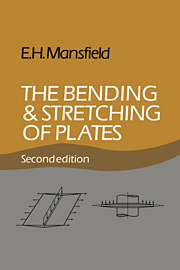9 - Asymptotic large-deflexion theories for very thin plates
Published online by Cambridge University Press: 07 October 2009
Summary
The exact large-deflexion analysis of plates generally presents considerable difficulties, but there are three classes of plate problems for which simplified theories are available for describing their behaviour under relatively high loading. These ‘asymptotic’ theories are membrane theory, tension field theory (sometimes called wrinkled membrane theory) and inextensional theory. All are described below. For a plate of perfectly elastic material, the error involved in using these theories tends to zero as the loading is increased or as the thickness is reduced. In any practical material, however, there is a limit to the elastic strain that may be developed, and this in turn limits the range of validity of these asymptotic theories to plates which are very thin. For steel and aluminium alloys, a typical limit to the elastic strain is 0.004, and this restricts the range of validity of the asymptotic theories as follows. For membrane theory and tension field theory the thickness must be less than about 0.001 of a typical planar dimension, while for inextensional theory the thickness must be less than about 0.01 of a typical planar dimension.
Membrane theory (considered by Föppl 1907)
When a thin plate is continuously supported along the boundaries in such a manner that restraint is afforded against movement in the plane of the plate, the load tends to be resisted to an increasing extent by middle-surface forces.
- Type
- Chapter
- Information
- The Bending and Stretching of Plates , pp. 183 - 224Publisher: Cambridge University PressPrint publication year: 1989



